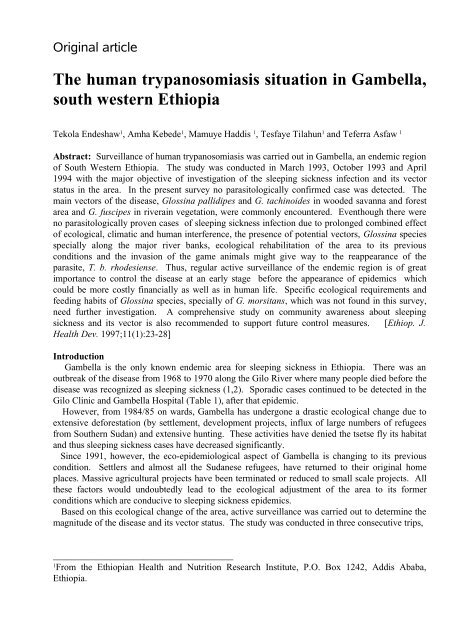Original article - Ethiopian Review
Original article - Ethiopian Review
Original article - Ethiopian Review
- No tags were found...
Create successful ePaper yourself
Turn your PDF publications into a flip-book with our unique Google optimized e-Paper software.
<strong>Original</strong> <strong>article</strong>The human trypanosomiasis situation in Gambella,south western EthiopiaTekola Endeshaw 1 , Amha Kebede 1 , Mamuye Haddis 1 , Tesfaye Tilahun 1 and Teferra Asfaw 1Abstract: Surveillance of human trypanosomiasis was carried out in Gambella, an endemic regionof South Western Ethiopia. The study was conducted in March 1993, October 1993 and April1994 with the major objective of investigation of the sleeping sickness infection and its vectorstatus in the area. In the present survey no parasitologically confirmed case was detected. Themain vectors of the disease, Glossina pallidipes and G. tachinoides in wooded savanna and forestarea and G. fuscipes in riverain vegetation, were commonly encountered. Eventhough there wereno parasitologically proven cases of sleeping sickness infection due to prolonged combined effectof ecological, climatic and human interference, the presence of potential vectors, Glossina speciesspecially along the major river banks, ecological rehabilitation of the area to its previousconditions and the invasion of the game animals might give way to the reappearance of theparasite, T. b. rhodesiense. Thus, regular active surveillance of the endemic region is of greatimportance to control the disease at an early stage before the appearance of epidemics whichcould be more costly financially as well as in human life. Specific ecological requirements andfeeding habits of Glossina species, specially of G. morsitans, which was not found in this survey,need further investigation. A comprehensive study on community awareness about sleepingsickness and its vector is also recommended to support future control measures. [Ethiop. J.Health Dev. 1997;11(1):23-28]IntroductionGambella is the only known endemic area for sleeping sickness in Ethiopia. There was anoutbreak of the disease from 1968 to 1970 along the Gilo River where many people died before thedisease was recognized as sleeping sickness (1,2). Sporadic cases continued to be detected in theGilo Clinic and Gambella Hospital (Table 1), after that epidemic.However, from 1984/85 on wards, Gambella has undergone a drastic ecological change due toextensive deforestation (by settlement, development projects, influx of large numbers of refugeesfrom Southern Sudan) and extensive hunting. These activities have denied the tsetse fly its habitatand thus sleeping sickness cases have decreased significantly.Since 1991, however, the eco-epidemiological aspect of Gambella is changing to its previouscondition. Settlers and almost all the Sudanese refugees, have returned to their original homeplaces. Massive agricultural projects have been terminated or reduced to small scale projects. Allthese factors would undoubtedly lead to the ecological adjustment of the area to its formerconditions which are conducive to sleeping sickness epidemics.Based on this ecological change of the area, active surveillance was carried out to determine themagnitude of the disease and its vector status. The study was conducted in three consecutive trips,______________________________________1From the <strong>Ethiopian</strong> Health and Nutrition Research Institute, P.O. Box 1242, Addis Ababa,Ethiopia.




![to read the full report [pdf, Amharic] - Ethiopian Review](https://img.yumpu.com/52737829/1/190x245/to-read-the-full-report-pdf-amharic-ethiopian-review.jpg?quality=85)











